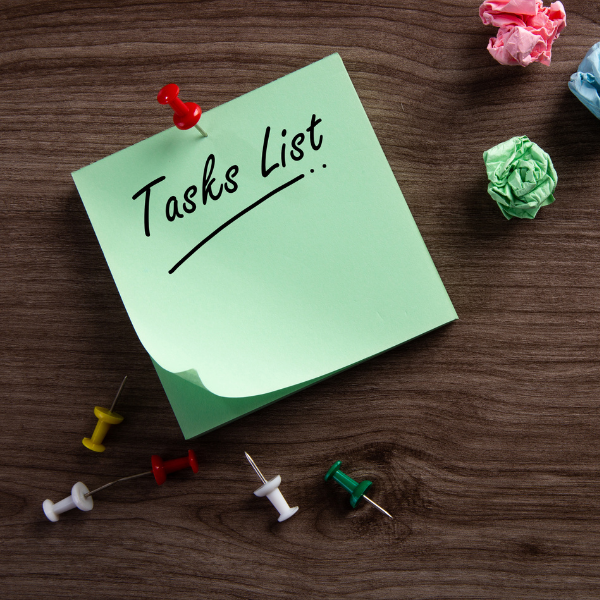Why Coaches should be paying close attention to job crafting
How job crafting can create a unique employer brand for your organisation or clients
5 Ways Coaches and Consultants Can Help Improve Their Client’s Employer Branding Using Job Crafting
101 examples of job crafting
People curious about job crafting often ask for examples of how others have crafted their jobs. Job crafting, for anyone that doesn’t know is making small tweaks and changes to a job to make it a better fit for the individual.
Part of the work and research we do in job crafting is to uncover and share job crafting examples from ‘in the wild.’
Here are 101 examples of some of the weird and wonderful ways people have personalised, shaped and crafted their jobs.
All of these examples are based on a person’s own context so some of this may not apply or be relevant to your personal and professional circumstances. See this list as a source of inspiration rather than a source of ideas to copy…
Task Crafting
Task crafting is tangibly changing aspects of how we undertake our work including designing, adding or removing tasks.
Examples:
Protect the first 30 minutes of the day to focus on specific tasks
Only respond to emails between 9am-11am or 4pm-5pm
Do the hardest task first thing when energy is at its highest
Experiment with voice-to-text software for faster email, report and content writing
Do admin on a Friday when the mood is more positive
Limit non-essential meetings
Use the pomodoro method for time management [look it up!]
Record voice notes for colleagues
Delegate or swap tasks that aren’t enjoyable or don’t play to strengths
Say no to requests that don’t align with the purpose of the role
Find ways to channel a strength e.g. creativity into everyday work
Strategically structure the work day
Experiment with tools like Slack or Teams for effective comms
Ask to start a workplace Team group for those who enjoy more social time
Call a colleague rather than email
Work collaboratively using Google Docs instead of Microsoft Word
Hire someone to do specific and expert tasks e.g. finances
Get involved in more client facing meetings
Schedule all meetings for the afternoons to keep morning free
Shorten all meetings by 10 minutes
Skill Crafting
Skill crafting is developing, refining and focusing on new skills.
Examples:
Shadow a colleague doing a specific task
Say yes to a scary project
Learn a new skill or piece of knowledge
Take a course or programme on an area you want to improve
Attend a lunchtime webinar
Ask for help on a difficult subject
Watch YouTube videos to improve a skill
Ask for constructive feedback
Find an opportunity to speak to a group (e.g. to enhance public speaking skills)
Organise team social events (e.g. to utilise planning skills)
Experiment with different meeting styles
Set a goal of writing 5 blogs each quarter
Listen to a podcast related to work on the commute
Delegate 15 minutes before work to focus on a new/current skill
Each team member shares something new they’ve read / learned each week
Ask to gain experience one day a week in a different team
Experiment with a new digital tool (e.g. to get better at presentation design)
Follow a top tips page on a specific topic on social media
Enquire about arranging a lunch and learn for colleagues
Set a goal to learn 5 new things about a topic
Purpose Crafting
Purpose crafting is reframing how we think about our work. in general including the value and significance it brings to us personally and others.
Re-frame the importance and value of tasks you enjoy less (e.g. doing finances shows your care for the business)
Make a daily list of the best interactions with customers / clients
Volunteer for projects that you find meaningful
Write a blog post about what you love about your work
Share your passions at work (e.g. start a running club)
Attend a conference on a subject you are passionate about
Become an advocate or champion for something you care about (e.g. inclusion, sustainability)
Survey service users to better understand their needs and how your work can add value
Volunteer to support new starter induction events
Get involved in client facing calls to understand the impact of your work
Learn more about the people your role is helping
Explore the impact of your role on the wider organisation
Reflect each day on the person that you have helped the most
Write down the purpose of your role before every work shift
Say no to tasks that don’t align with your role purpose
Ask for feedback on projects (to see how you have made an impact)
Create a petition for a recycling bin at work
Reframe work travel as an opportunity to explore new places
Meet with customers of projects you have delivered in the past
Create a case study for every new piece of work and share this externally
Relationship crafting
Relationship crafting is shaping how we relate and engage with others, including building and adapting our relationship with co-workers.
Examples:
Write thank you notes to colleagues at the end of each week to express gratitude
Pop into someone else’s office to see how they’re doing
Start a breakfast club
Organise a team away day
Schedule informal 1:1 check-ins to compliment more formal 1:1s
Set up a random coffee scheme that pairs colleagues from across the organisation to meet for coffee
Allow time for informal “chit chat” before meetings
Spend less time with people that can drain your energy levels
Grab lunch with a colleague from a different team once a month
Start a book club
Offer to mentor a new colleague
Ask someone about their passions outside of work
Chat to someone about something non-work related
Seek support to address a negative relationship
Recognise and praise a colleague when you see it
Walk to the coffee shop together as a team
Make connections with clients to foster a relationship
Set a goal to learn something new about each team member
Arrange to catch up with a new starter
Connect with someone from a different team
Wellbeing crafting
Wellbeing crafting is boosting our physical and mental health through the work we do.
Example:
Go for a 15 minute walk at lunchtime
Mindful walking up and down the corridors to collect patients
Switch your phone and email notifications off in the evenings
Arrange walking meetings
Watch 10 minutes of Netflix at lunch time to switch off
Have a coffee break in the garden
Yoga before work
Introduce a ‘fake’ commute to help start and end the day
Use a standing desk
Say no to non-critical work requests
Get into a routine of leaving work on time (e.g. leave the office with a buddy)
Take a tactical nap
Bring nutritious snacks to work
Ensure you take regular breaks
Cycle/run to work
Try having one day a week that is meeting free
Treat yourself to a lie in once a week - start and finish later that day
Take the stairs instead of the lift
Listen to music whilst working on a project
Get away from the desk at lunch time
Job crafting example number 101:
Write down 3 good things at the end of the work day.
Can you guess which type of job crafting this is? 5 gold stars if you can!
We hope that you found these examples inspiring and that you can try out job crafting for yourself.
For more information on job crafting please click here or email us if you fancy a chat at [email protected]
Happy crafting!
GPs are job crafting and it’s having a positive impact
“It’s time to harness the creativity of the workforce and trust people to make change to hit that sweet spot of optimising service delivery, it’s a win win”.”
A new study has uncovered job crafting and flexible work design are having positive benefits for GPs across the UK. The Institute of Employment Studies (IES) has recently carried out a research project, testing this with 6 different GP practices across the UK, and the outcomes were compelling. This blog was informed by chatting with Stephen Bevan, one of the researchers involved in the study.
An important aspect to highlight in this study is that the researchers were keen to explore beyond the conventional methods of job design, for example, changing working days, hours or rotas. Although compressed hours were deemed the most attractive option to most people in the study, researchers were most interested in ideas beyond that. For example, how people can swap tasks with colleagues to suit their individual needs and benefit their own professional development.
What was the purpose of the study?
Originally, the team was asked to look at GP burnout. However, they quickly realised from the research that whilst there was some evidence of job crafting and flexible work design across the NHS, there are very few examples of this in general practice. Hence the desire to do this research.
Why GPs?
The Covid-19 pandemic put a huge strain on the NHS and left GPs feeling exhausted, burned out, and lots of practices saw GPs quitting as a result. It was evident that something needed to change. An underlying theme for GPs was the pressure they felt to continue delivering high quality care.
What did the study do?
With support from NHS England, IES put a call out to see if there were any GP practices in the UK interested in taking part in the study selection process. The institute was looking for 6 practices that met a range of different attributes, with the main criteria being a diverse practice with a variety of ages, races, genders, etc. Several conversations with practice managers took place to ensure that they could collect data without putting additional pressure on their already extremely busy workloads.
How did they carry out the study?
The researchers identified four to five people in each practice who had agreed to take part in the study, and carried out semi-structured interviews before and after their shifts.
A specific example of job crafting in general practice
GP practices often get hundreds of frequent callers for many different reasons. An advanced nurse practitioner took on the role of reaching out to patients before their conditions became acute. This involved monitoring and proactively contacting patients to ensure they felt looked after. As a result, this change in approach was a win-win for GPs and patients - preventing repeat callers, and crowding appointments, as well as ensuring patients didn’t deteriorate in health.
“Evidence tells us that individuals having autonomy and control in their jobs leads to better performance, retention, and wellbeing. ”
Key outcomes
There were a number of notable outcomes from the project:
GPs felt empowered to explore ways in which they could get their work done in a different way.
Transition to working patterns which allowed GPs to deliver care which accommodated flexible working and promoted physical and psychological wellbeing.
Significant progress to more agile and responsive models of organising work
GPs were able to better define the boundaries between job roles and responsibilities
More opportunity for professional development, aligning to fulfilling work
Able to deliver their goal that patients would receive the highest level of care, leading to feelings of better job satisfaction.
Conclusion
Overall, this study has had a positive impact on GP surgeries across the UK, leading to a domino effect of benefitting the GP, the practise and of course the patient. The paper concludes: “although this has not created a perfect solution, most GPs would agree that they had made significant progress to more agile and responsive models of organising work”.
You can read the whole research paper here.
If you’re interested in learning more about job crafting or testing this within your organisation, please contact us at [email protected].
Setting a job crafting goal in 2023
You might have heard about a concept called job crafting. As experts, we talk about it a lot and the media are finally catching on. The pandemic gave us a flavour for personalising our jobs, we began to work with freedom and autonomy, like adapting when and where we worked. It shifted the working world on its head, opening up a huge opportunity to start crafting our job.
Job crafting is about making small, tangible and personal changes to our job to make it a better fit for us as individuals. There are 5 ways you can craft your job: skill crafting, task crafting, relationship crafting, wellbeing crafting and purpose crafting.
However, we recognise that making change is hard. New Year’s resolutions only have a 40% success rate. If setting goals and making change was easy, we would have a 100% success rate. To help you, we’re sharing a goal-setting template, created by our founder and job crafting specialist, Rob Baker.
Job crafting goal-setting template.
Rob recommends that you consider 6 different factors when developing and committing to a job crafting goal:
1) Goal - what is my job crafting goal?
Write down your goal as concise as possible. The clearer you are the better. Make your goal small so it can be achieved in under 10 minutes a day or an hour a week in total.
2) Significance - why is this goal important?
Articulate the reasons for setting a / your job crafting goal. This enables you to consider why this change matters to you, and will help tap into your internal motivations and values.
3) Trigger - what are my triggers?
Write down any triggers that are associated with your job crafting goal. These are physical or mental cues that remind you to act on your new job crafting habit.
4) Barriers - what are the potential barriers?
This requires you to reflect on your practicalities of the goal you are setting and the different hurdles which might prevent you from achieving your goal.
5) Reward - how am I going to reward myself?
Write down how you will recognise or celebrate the achievement of your goal. This can be anything you want. A cup of coffee, your favourite snack, a social media break, you choose! Each individual is different, therefore personalise your reward to something personal to yourself.
6) Accountability - who am I going to be accountable to? And how are we going to check in?
Identify an accountability buddy who you can share your goal with. This can be anyone, a colleague, a partner, your gran, whoever you like. Consider how you are going to check in with each other and this will get you to start planning and identifying opportunities to speak, which makes it more likely to happen.
Goal-setting example
Expressing gratitude to others.
Customer service manager Sue has felt a disconnect from colleagues whilst working from home and values human connection and making others feel good. She wants her team to know she values their efforts and wants to get others into the habit of giving positive feedback.
Goal: To express thanks to a colleague by email, phone or in person once a day.
Why? I value the contribution of others and recognise the importance of human connection and a team effort. It makes me feel good giving thanks to others and it makes them feel good too.
Trigger? I’ll set a reminder on my phone each day at 16:30 to remind me to send a thank you note.
Barrier? Some days there may not be clear opportunities to thank people, especially if working from home. On these days I will think of the wider benefits of my job that I appreciate.
Reward? The feel-good factor of saying thanks and the accomplishment of completing my daily target and ending the day on a positive note.
Buddy? My partner at home, I’ll tell her each night at dinner who I thanked that day.
Reminder! This goal-setting framework is not a check-list, you don’t have to complete every stage. However, evidence and research suggests the more areas you address the more likely you are to be successful in achieving your goal.
If you would like to learn more about job crafting you can read more here, or if you need some help with your goal please get in touch via email: [email protected]
Using job crafting to shape my career
Michelle Reid, People and Operations Director at IOM (job crafting model).
Michelle Reid, People and Operation’s Director at IOM will be sharing her experiences of job crafting and how it has helped her shape her career. Michelle has a successful history in implementing, leading, and optimising multi-level business & HR practices.
Michelle was recently listed in the HR Most Influential List 2022.
I started my role as HR Manager at IOM 5 years ago. The purpose of our organisation is to improve the health of people in their workplace and in the wider environment.
When I joined the company, what they thought they wanted wasn’t actually needed. As a result, my role now is completely different and I have used job crafting to shape it in a significant number of ways. FYI job crafting is making small, tangible changes to your job to make it more meaningful, engaging and a better fit for you as an individual.
Job crafting for me is very much aligned to my purpose. My purpose is to unlock the value of people to unleash commercial success. If there are tasks on my to-do list that don’t align with my purpose then I’ll ditch them in favour of investing my time into tasks that do.
In this blog I wanted to share with you some job crafting examples, including the 5 different ways I have crafted my job.
The 5 types of job crafting
Task crafting
At IOM, I have full responsibility for the HR function end to end, so I have to think cleverly about the tasks that I do. The way I task craft is by thinking about the tasks I enjoy doing, those I don’t enjoy doing, and how I can delegate tasks to people who may have an interest in some of my tasks (this takes the pressure off me).
A great exercise to kick start task crafting is the love and loathe exercise.
Relationship crafting
Relationship crafting is about understanding people and the relationships we have with them
When I first joined IOM the first thing I did was walk around and talk to every single person. This wasn’t with the aim of understanding what people did in their roles, but to understand how they felt about working for IOM and what they liked and disliked about the organisation. I also asked them what they would change if it was their business and what they thought was standing in their way.
This enabled me to think about where I needed to apply my skills and knowledge to help drive improvements for them. So my relationships were at the heart of that. I have become a relationship chameleon, adapting my relationships and crafting my approaches to different people and circumstances.
Purpose crafting
Purpose crafting is the one I find harder than anything else.
Subconsciously, I knew my purpose deep down. But it is only in the last 2 years that I came to this realisation and I have written it down in front of me in my diary ever since. As soon as people are connected to their purpose, the physical tasks they do, the relationships they have the skills they hold and how they feel, everything becomes aligned. They move to a growth mindset rather than a fixed mindset. They are not wedded by their job descriptions, titles or how they have always done things, they begin to think “why am I doing this, can this be done better, what more can I do or bring?”
Skill crafting
I find skill crafting the easiest because I’m so nosey!
I know I don’t know everything so I’m always consciously trying to learn lots of new things. So if there is something I’m curious about I just go and find it out. Google is my best friend! I’m constantly building new skills all of the time with less of a reliance on going to a course, skills are things that are crafted and learned in lots of different new ways including great conversations with others who are in the know. Skills sharing is brilliant and builds the feeling of reciprocation and value.
Wellbeing crafting
In regards to other people's wellbeing I’d say I’m great. In regards to my own… not so good.
A recent example involves an employee whose job is a combination of both physical and mental activities. Therefore they typically experience an energy dip mid-week. One of the ways they boost their energy is cycling, but they usually have to wait until the weekend to do this. I told him to take a few hours midweek to go cycling! He has now seen an increase in his energy, productivity and motivation, a no brainer for the business and for him.
Areas I want to improve in job crafting
Job crafting is something I do without thinking. However, one area I know I need to improve on is wellbeing crafting. When I’m feeling tired or drained, exercise is the first thing to go. It’s something that fills my tank, yet the thought of cardio puts me off all together. Even though I know it does wonders for my mental and physical health.
However, I have got into the routine of going to Zumba twice a week and I attend two external networking groups every Friday. Both of these activities boost my energy and productivity and make me feel good - win, win all round!
You can learn more about job crafting here, you can also connect with Michelle on LinkedIn if you would like to ask her any questions or have a chat.
















